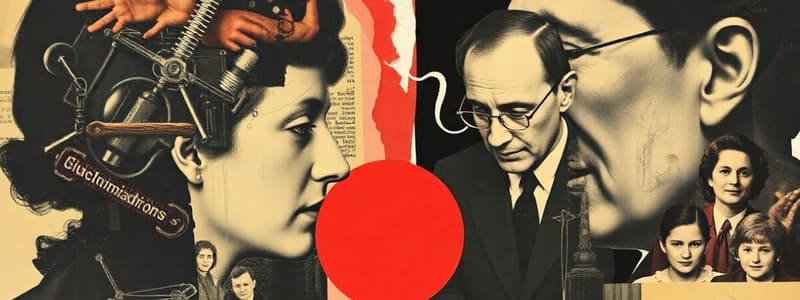Podcast
Questions and Answers
In individuals with schizophrenia, increased activity in the temporal lobe is most likely associated with which cognitive process?
In individuals with schizophrenia, increased activity in the temporal lobe is most likely associated with which cognitive process?
- Difficulties in naming the ink color of conflicting color words.
- Reduced blood flow in the frontal cortex.
- Deficits in central control.
- Auditory hallucinations due to misinterpretation of memories. (correct)
What do the results of the Stroop Test suggest about individuals with schizophrenia?
What do the results of the Stroop Test suggest about individuals with schizophrenia?
- They have deficits in central control during cognitive processing. (correct)
- They experience reduced activity in the temporal lobe.
- They exhibit increased blood flow in the frontal cortex.
- They are quicker at naming the ink color of conflicting color words.
Which of the following best describes a bidirectional effect in the context of schizophrenia and family dysfunction?
Which of the following best describes a bidirectional effect in the context of schizophrenia and family dysfunction?
- Family dysfunction is solely a result of schizophrenia.
- Family therapy is ineffective due to bidirectional effects.
- Family dysfunction can both contribute to and result from the individual's behavior. (correct)
- Family dysfunction is solely a cause of schizophrenia.
Why might the family dysfunction theory of schizophrenia be considered ethically problematic?
Why might the family dysfunction theory of schizophrenia be considered ethically problematic?
What is the implication of Gottesman's evidence regarding the genetic basis of schizophrenia?
What is the implication of Gottesman's evidence regarding the genetic basis of schizophrenia?
According to the 'schizophrenogenic mother' concept, which parental dynamic is most likely to contribute to the development of schizophrenia in a child?
According to the 'schizophrenogenic mother' concept, which parental dynamic is most likely to contribute to the development of schizophrenia in a child?
Which of the following best illustrates the 'double bind' communication pattern that may contribute to schizophrenia?
Which of the following best illustrates the 'double bind' communication pattern that may contribute to schizophrenia?
What is the primary characteristic of 'high expressed emotion' (EE) in families, as it relates to individuals with schizophrenia?
What is the primary characteristic of 'high expressed emotion' (EE) in families, as it relates to individuals with schizophrenia?
An adopted child with a biological parent with schizophrenia is raised in a psychologically healthy family. Based on the research discussed, what is the most likely outcome for the child regarding the development of schizophrenia?
An adopted child with a biological parent with schizophrenia is raised in a psychologically healthy family. Based on the research discussed, what is the most likely outcome for the child regarding the development of schizophrenia?
How does a 'faulty attention system' contribute to the experience of hallucinations and delusions in individuals with schizophrenia?
How does a 'faulty attention system' contribute to the experience of hallucinations and delusions in individuals with schizophrenia?
What is the primary difficulty associated with 'lack of central control' in individuals with schizophrenia?
What is the primary difficulty associated with 'lack of central control' in individuals with schizophrenia?
An individual with schizophrenia believes that their thoughts are being inserted into their mind by an external force. Which cognitive explanation best accounts for this delusion?
An individual with schizophrenia believes that their thoughts are being inserted into their mind by an external force. Which cognitive explanation best accounts for this delusion?
According to Hemsley's schema dysfunction theory, what is the core problem in schizophrenia?
According to Hemsley's schema dysfunction theory, what is the core problem in schizophrenia?
Flashcards
Auditory Hallucinations
Auditory Hallucinations
False perceptions of sounds that occur without external stimuli, often linked to misinterpreting memories.
Frontal Cortex Blood Flow
Frontal Cortex Blood Flow
Reduced blood flow in the frontal cortex is associated with negative symptoms like avolition in schizophrenia patients.
Stroop Test Results
Stroop Test Results
Patients with schizophrenia take longer than controls to name ink colors, indicating cognitive processing deficits.
Family Therapy Impact
Family Therapy Impact
Signup and view all the flashcards
Genetic Predisposition
Genetic Predisposition
Signup and view all the flashcards
Schizophrenogenic Mother
Schizophrenogenic Mother
Signup and view all the flashcards
Double Bind Theory
Double Bind Theory
Signup and view all the flashcards
Expressed Emotion
Expressed Emotion
Signup and view all the flashcards
Tienari's Study
Tienari's Study
Signup and view all the flashcards
Faulty Attention System
Faulty Attention System
Signup and view all the flashcards
Lack of Central Control
Lack of Central Control
Signup and view all the flashcards
Meta-representation Issues
Meta-representation Issues
Signup and view all the flashcards
Schema Dysfunction (Hemsley)
Schema Dysfunction (Hemsley)
Signup and view all the flashcards
Study Notes
Family Dysfunction in Schizophrenia
- Schizophrenogenic Mother: A theory suggesting a cold, rejecting, and controlling mother, alongside a passive father, can contribute to schizophrenia's development. Stressful upbringing can lead to psychotic thinking, like paranoid delusions.
- Double Bind Theory: Contradictory messages from caregivers can cause confusion, potentially leading to schizophrenia. Inconsistent expectations (e.g., independence vs. overprotection) can result in disorganized thinking and paranoia.
- Expressed Emotion: A measure of caregiver attitude towards a person with schizophrenia. High expressed emotion includes excessive involvement, criticism, control, and hostility.
- Butzlaff and Hooley's meta-analysis (27 studies) linked high expressed emotion with a higher risk of relapse in schizophrenia.
- Tienari's study showed adopted children of biologically schizophrenic mothers had a significantly higher chance (36.8%) of developing schizophrenia if raised in unhealthy families, compared to healthy families (5.8%). This highlights the environmental impact.
- The 5.8% rate in healthy families is considerably above the general population's 1%, suggesting a complex interaction between genetics and environment.
Cognitive Explanations
- Faulty Attention System: The attention system in schizophrenia struggles to filter irrelevant thoughts, leading to overloaded conscious thought, explaining hallucinations and delusions.
- Lack of Central Control: Difficulty inhibiting impulses and speech, causing confusion and difficulty explaining actions, contributing to speech derailment.
- Meta-representation Issues: Impaired self-reflection can lead to attributing thoughts/actions to external forces.
- Schema Dysfunction (Hemsley): Breakdown in connecting new information to existing schemas, leading to confusion, misinterpreting old memories as new experiences, contributing to auditory hallucinations.
Cognitive Evidence
- Brain Imaging (Firth): PET scans showed reduced frontal cortex blood flow in patients with negative symptoms (like avolition) and increased temporal lobe activity (memory retrieval) in patients with reality distortion.
- Stroop Test (Stirling): Schizophrenia patients took significantly longer than controls on the Stroop Test, indicating deficits in central control.
Evaluation
- Family Therapy Success: Family therapy's proven effectiveness supports the role of family dysfunction in schizophrenia.
- Cognitive Behavioral Therapy for Psychosis (CBTp) Success: CBTp's effectiveness reinforces the significance of cognitive processes in schizophrenia.
- Ethical Concerns: The family dysfunction theory can inadvertently blame families, adding stress to those already struggling.
- Bidirectional Effects: Family dysfunction might not only cause but also result from the individual's behaviors.
- Genetic Predisposition: Gottesman and others highlight a genetic predisposition to schizophrenia, emphasizing biological factors like neurotransmitter imbalances.
- Interaction of Biological and Psychological Causes: Schizophrenia likely involves both biological and psychological factors.
Studying That Suits You
Use AI to generate personalized quizzes and flashcards to suit your learning preferences.



